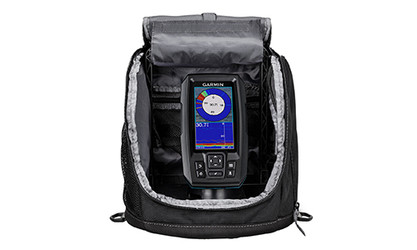At Fish307 we stock all of your ice fishing electronic needs. From ice fishing finders, ice fishing flashers, Sonar GPS equipment and batteries - we got you covered!
Ice Fishing Flashers and Fish Finders
Did you know that fish finders work through the ice? The best ice fishing flashers can detect fish through thick ice, so you can find the best spot to cast your line. Fish finders can seriously improve your chances of a successful day of ice fishing.
Without an ice fishing flasher, anglers have to guess where the fish will be. After carving a hole in the ice, casting your line, and waiting a while, you may realize that the fish just aren’t there. With a fish finder, you can find out where the fish are hiding before you take the time and effort to cut a hole in the ice, set up your gear, and wait. If you can’t see where the fish are, it’s harder to catch them.
With a flasher or fish finder, you can see where the fish are located so that you can make the catch! Whether you use this sonar technology before or after carving your hole in the ice, it maximizes your success in finding and catching fish.
How Does GPS Sonar Work Through the Ice?
Fish finders use sonar technology to send a sonar wave down, through the ice. Once the wave hits something, it sends that information back to the device. Flashers can detect the bottom of the lake, any fish present, and even your lure, and transmit the depths of each, so you can better detect and catch fish through the ice.
Ice fishing fish finders and flashers are meant to be used once you’ve already dug your hole, and then you can place the transducer in the water to read below it. They can also work straight through the ice without digging a hole, however. All you need is clear, even ice - pour some water on it, and firmly place the transducer so that it is steady. It will read through the ice, although you may have to turn up the sensitivity of the sonar.
What is the Difference Between Fish Finders and Flashers?
Fish finders and flashers are terms that are often used interchangeably. Both can work to find fish in a frozen lake, although flashers are made specifically for ice fishing. Most serious ice anglers prefer ice fishing flashers over fish finders.
Ice fishing flashers use a more basic form of sonar, so you won’t see an LCD screen output, but rather dials that change color depending on what they find. Flashers provide information like the depth of the water, any fish passing underneath and their depth, and where your line and lure are located.
Traditional fish finders offer more information, but some of them are not useful when ice fishing. They also use sonar, and many have more powerful CHIRP sonar. Some standard fish finders are not compatible with the cold, but an added transducer will allow them to function in freezing temperatures.
The main drawback of using a fish finder for ice fishing is that their battery often struggles to hold up in the cold. Flashers are made for cold temperatures, so their battery works better in these conditions. Ice fishing flashers also give data in real-time, while fish finders may lag slightly.
Underwater Ice Fishing Cameras
Aside from flashers and fish finders, there are also underwater fishing cameras you can use to find fish. To use these, you must carve a hole in the ice first, and simply drop the camera in so that it transmits images back to your screen.
With an underwater fishing camera, you can see the actual fish below, so you’re getting more information than you would with sonar.
Ice Fish Finder Batteries and Accessories
To combat the cold, pack an extra battery! Fish307 provides ice fish finder batteries and accessories to make the most of your ice fishing electronics.
In the cold, batteries drain faster as the electronics have to put forth more energy. Since there aren’t any outlets on a frozen lake, an extra battery could bring your equipment back to life.
There are other ice fishing electronics accessories offered as well, like ice transducers to attach to fish finders, replacement parts, chargers, and more.


